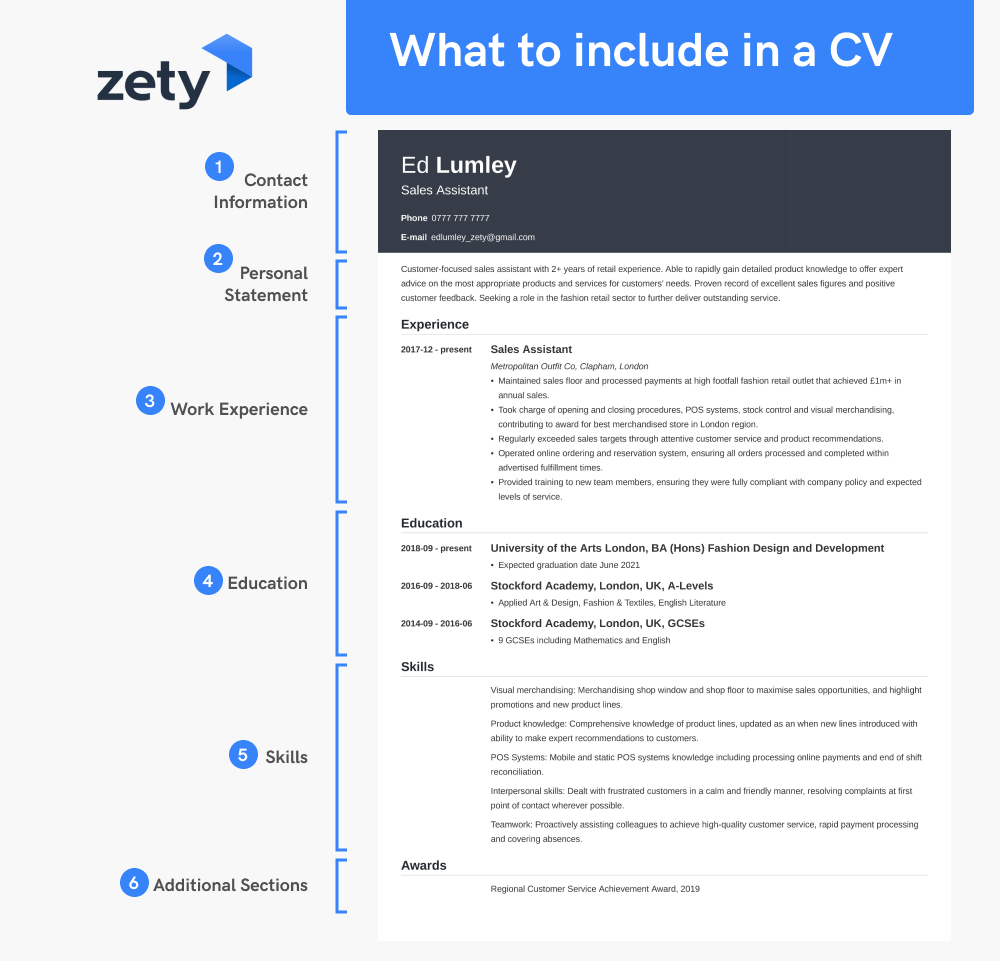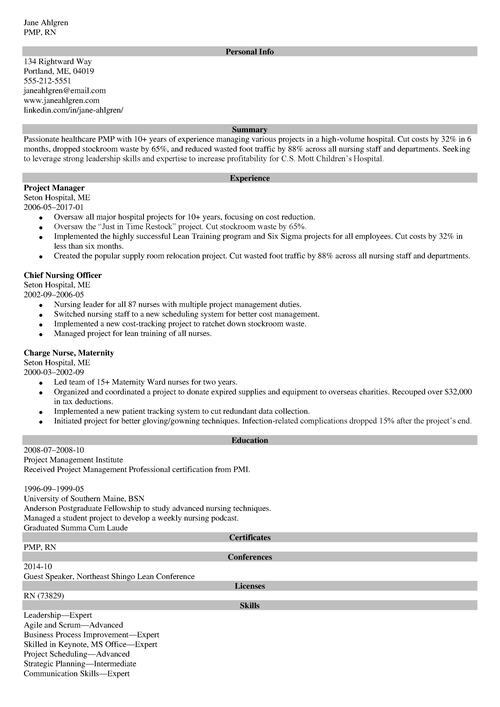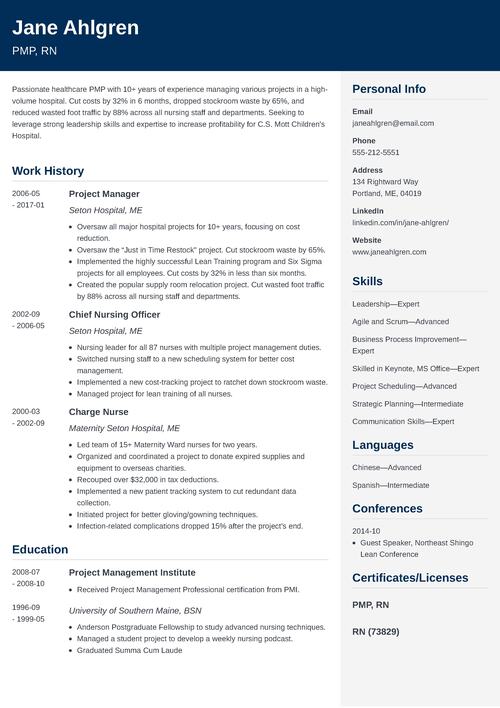What to Include in a CV: Key CV Sections Explained
Create your CV nowWriting a CV doesn’t have to be stressful. Knowing exactly what to include in a CV can make all the difference. In this guide, you’ll discover what to put in a CV: from the key CV sections to other things that can make your job application stand out. Get ready to build a CV that brings you closer to your dreams!
This guide will show you:
- What goes on a CV, and what CV sections order should you pick.
- What information to put in each of the CV parts.
- What not to include on a CV so you don’t sabotage all your hard work.
- An example of what should be on a CV so you can check that you’ve included everything.
Want to save time and have your CV ready in 5 minutes? Try our CV builder. It’s fast and easy to use. Plus, you’ll get ready-made content to add with one click. See 20+ CV templates and create your CV here.
Sample CV made with our builder—See more templates and create your CV here.
One of our users, Nikos, had this to say:
[I used] a nice template I found on Zety. My CV is now one page long, not three. With the same stuff.
Want to discover even more about CV writing? Read more here:
- Graduate CV Examples and Template
- Student CV Examples and Template
- 20+ Job-Winning CV Tips & Advice
- 18+ Basic CV Templates to Download
- 20+ Free CV Templates to Download
What to put on a CV?
A CV (short for curriculum vitae) should include your contact details, a personal profile, description of your work experience, educational background, and professional skills. Apart from these essentials, you can also include additional sections such as languages, certificates, personal projects, and volunteer experiences.
Here’s a breakdown of what each section of a CV should include:
1. Contact information
Include the following information in your CV contact section:
- Your full name
- Your job title
- Phone number
- Your email address
- LinkedIn profile
- Optional: links to other social media or your professional website
Details you should never include in your CV:
- Your photograph
- Personal info such as date of birth or marital status
- Postal address
💡 Wondering why you shouldn’t include your postal address? Simple: it’s unnecessary. Job applications are no longer sent via Royal Mail. Leave off your postal address and give yourself more room for the important stuff.
2. CV personal statement or profile
Your CV personal statement (or CV personal profile) is a brief paragraph of 2–4 sentences that follows your contact information. In a nutshell, the sole purpose of your personal statement is to get the hiring manager to read the rest of your CV.
Your CV profile should include answers to these three questions:
- Who are you?
- What can you offer to the employer?
- What are your career goals?
Your approach will vary depending on your level of seniority.
If you’re applying for a job where you do have relevant experience:
- Make a master list of your strengths, including your professional experience, skills and abilities.
- Then check the job advert for the role you’re applying for, read the job description, highlight the skills and experience it requires and match the results with 3–4 points from your list.
If you’re applying for an entry-level role or you’re a career changer, then do this instead:
- Make a master list of your strengths. Consider your education and any other jobs you’ve had. And list those that are transferable to the job you’re applying for.
- Choose 3–4 relevant items and combine them with passion for the role and knowledge about the employer to prove that you’ll be a good fit.
Whatever your level of experience, ensure your personal statement is targeted to the job you’re applying for. Don’t just use the same old profile for every application.
What to include in a CV: personal statement example
Highly motivated receptionist with 5+ years of experience in busy front desk roles. Immaculately presented with highly developed communication skills and pride in giving an outstanding first impression to clients and visitors. Looking to take on new challenges that enable my calm and focused approach to shine.
This section is much easier to write if you leave it until last. You’ll find it helps to have your experience, skills and education already in front of you and ready to refer to.
💡 Read more: How to Write a CV Personal Statement: CV Personal Profile Examples
3. Work experience
This is the most important section of your CV. It’s no surprise that 92% of recruiters say previous job experience is the key hiring factor to consider. However, you can’t simply list your work history in your CV and hope for the best!
📝 Here’s how to make a great work experience section for your CV:
- List your work experience in reverse-chronological order.
- Include the job title, employer, and dates of employment for each role.
- Include up to six bullet points outlining responsibilities and achievements. Don’t just say what you did, say how well you did it.
- Use the PAR (Problem Action Result) formula and accomplishment statements to structure your bullet points.
- Add interest and impact with CV action words. Forget ‘responsible for. ’ Try snappy alternatives like: operated, undertook, and performed.
- Target your work experience to the job you’re applying for. Focus on experience that’s relevant to the requirements in the job advert.
Parts of a CV: work experience section example
Customer Service Advisor
Senco Systems, Greater Manchester
November 2022–Present
Key Responsibilities:
- Provided telephone and online customer support for 100,000+ customer accounts across the UK.
- Resolved 90% of complaints at first point of contact, exceeding corporate target of 80%.
- Meticulously updated customer information on CRM as and when required and adhered to GDPR requirements.
- Delivered onboarding to new starters and refresher training to established team members.
Key Achievement:
- Exceeded the complaint resolution quality goal of 90% achieving a score of 96%+.
4. Education
The structure of this section depends on your level of professional experience.
🎓 If you’ve got more than two years of work experience, and you’re a university graduate, only list your degrees and include the following:
- Degree start date and graduation date
- Name of degree
- Institution you attended
CV education section example
BA (Hons), 2:1, History
University of Manchester, UK
September 2014–June 2017
🎓 If you’re a university graduate with less than two years of work experience, or you’re still studying, you can include additional information. Add a subsection containing coursework, and include an expected graduation date if you’re still learning.
Recent graduate CV education section example
Economics BSC (Hons)
University of Manchester, UK
September 2025–June 2027 (Expected graduation date)
Relevant Coursework: Econometrics, Mathematical Economics, International Trade & Finance
🎓 If you’re a school-leaver, then simply list your A-levels and GCSEs. Include individual subjects for your A-levels, but for your GCSEs, you only need to list Maths and English. Many employers look for passes in these subjects as a minimum requirement. No need to include grades for individual subjects unless you’re specifically requested to do so.
School leaver CV education section example
A-levels: Business, Computer Science, English Literature. September 2023–June 2025
Stockford Academy, London, UK
9 GCSEs including Mathematics and English, September 2021–June 2023
Stockford Academy, London, UK
When making a CV in our builder, drag & drop bullet points, skills, and auto-fill the boring stuff. Spell check? Check. Start building a professional CV template here for free.
When you’re done, Zety’s CV builder will score your CV and tell you exactly how to make it better.
5. Skills
This rounds up the last of the must-have CV sections. Last, it may be, but certainly not least. A massive two-thirds of employers value soft skills more than the candidate’s educational background when making their hiring decisions.
What are the most essential skills to include in a CV? You guessed it: skills that are relevant and targeted to the job you’re applying for. Here’s how to pick them:
- Read the job advert and identify the desired skills for that position. Write those skills down in a list.
- Create a list of all your skills, referring back to your work experience and education sections for inspiration.
- Compare the two lists, see what matches, and choose 5–10 of those to include in your CV. Aim for a mix of soft skills, hard skills, and technical skills.
- Add a single sentence showing how you demonstrated each skill in the past. Don’t just show, tell.
What should be on a CV: skills section example
- Written communication skills: Prepared monthly company newsletter based on briefings from senior managers.
- Adaptability: Maintained a high standard of service delivery during the emergency office move and the unexpected long-term absence of team members.
- Contract management: Kept supply and service costs within budget through effective negotiation with contractors.
- Analytical skills: Shown in researching blockages in team processes to improve efficiency.
- Performance management: Maintained regular schedule of 1-1 meetings and introduced new annual performance review process.
So that’s the last essential section dealt with. But you need to stand out from the 118 other applicants who want the job, too. So let’s see what else you can include in your CV to beat your competitors!
💡 Read more: Key CV Skills: Best List of Top Skills and Examples
6. Additional CV sections
The bare essentials aren’t going to cut it if you want to be one of the few candidates who score an interview. If you’ve got something extra, then make good use of it!
📝 Here are the additional sections you can include in a CV:
- Hobbies and interests: An underappreciated CV section. It’s a great way of setting yourself apart as an individual. Just avoid choosing hobbies that are too unusual. Psychokinetic fork bending isn’t relevant to many careers.
- Volunteering: Including volunteering on your CV has a potent effect because it demonstrates initiative, community engagement, and a willingness to develop skills beyond paid work, all of which signal to employers that you are proactive, adaptable, and driven by more than just financial gain.
- Languages: Foreign language skills are another brilliant thing to put in your CV. Language skills are required at all levels of the workforce, and the most in-demand languages are German, French, and Spanish.
- Professional certifications
- Extracurricular activities
- Projects
- Publications
- Awards
- Conferences
💡 A good CV is more than the sum of its parts. Learn more:What’s a Good CV Like in 2025?
How to order the key CV sections?
No matter what job you’re applying for, there’s a set CV order of sections you have to follow if you want to create the best CV template possible. It depends on what stage you’re at in your career. In a typical reverse-chronological CV, the education and work experience sections can change places depending on your circumstances.
Order of CV sections for experienced candidates
- Contact information
- Personal Statement (aka Personal Profile)
- Work Experience
- Education
- Skills
- Additional sections
Order of CV sections for candidates with little or no experience
- Contact information
- Personal Statement (aka Personal Profile)
- Education
- Work Experience
- Skills
- Additional sections
Both situations above apply to a chronological CV format only. For a skills-based CV, the rules are slightly different.
💡 Read more here to find out all about the two main types of CV format: CV Format: Best Examples for Job Hunting Success
What to put on a CV: example
This example shows you what each CV section is called and where it should be included:

What additional things to put on a CV?
Remember: you’re applying for a job, not putting together a puzzle. There’s more to a CV than simply fitting the sections together.
What else do you need to include in a CV?
Relevant keywords
The recruitment process is becoming more automated and data-driven. Many companies use ATS software to scan job applications. Applicant Tracking Systems scan your CV for keywords and reject any that don’t include what’s required, all before a human even sees them.
CV keywords are words and phrases that describe desired experience, skills or traits. The job title is also a keyword. Thankfully, you’ll find them laid out for you in the job advert.
CV keywords example
Suncom Systems seeks an accomplished office manager with 5+ years of experience. Must be proficient in supplier contract management and have experience managing a team of office assistants.
Everything in bold is a CV keyword. Use them well: don’t just string keywords together. Ensure your CV remains grammatically correct and easy to read.
Proper layout
Your CV needs to look great and be readable as well. The best way to achieve that is with a practical CV layout. Here’s what to do:
- Set page margins to one inch on each side, left-align the text (don’t use justification) and double space between each section. This creates ample white space, which enhances readability and adds emphasis to each section.
- Choose a good CV font. Arial, Helvetica and Cambria are three great options.
- Be concise. The best CV length is no more than two pages.
- Save your CV as a PDF. It’s the best file type for keeping your layout intact.
💡 To learn more about how to write a CV, read more here: How to Write a CV: Professional Examples for the UK
What to include in a CV: video
Plus, a great cover letter that matches your CV will give you an advantage over other candidates. You can write it in our cover letter builder here. Here's what it may look like:
See more cover letter templates and start writing.
Key takeaways
✅ Here’s what you should include in a CV:
- Essential CV sections: contact information, personal statement, work experience, education, and skills.
- Additional sections you can put on a CV include: professional certifications, hobbies and interests, languages, volunteering, projects, publications, awards, and conferences.
- Other good things to put in a CV are: keywords and a practical layout.
- Don’t include: your photo, personal information, or your postal address.
About Zety’s Editorial Process
Our editorial team has thoroughly reviewed this article to ensure it follows Zety’s editorial guidelines. Our dedication lies in sharing our expertise and providing you with actionable career advice that offers you real value. Every year, the quality of our content attracts 40 million readers to our site. But that’s not all – we conduct original research to gain a detailed understanding of the labour market. We take pride in being cited by top universities and leading media outlets in the UK and worldwide.
Sources
- Jobvite, “2017 Recruiter Nation Report"
- Portland Community College, “Samples of PAR formula statements”
- LegalJobs, "30 Mind-Blowing Interview Statistics to Get You Going in 2023"
- People Management, “Two-thirds of employers value soft skills more than educational qualifications when hiring, research finds”
- S. Coates, "White Space: An Overlooked Element of Design"







